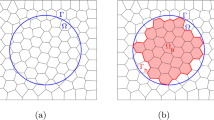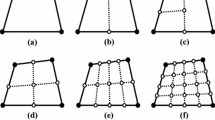Abstract
A variational algorithm for the construction of 3D Delaunay meshes in implicit domains with a nonsmooth boundary is proposed. The algorithm is based on the self-organization of an elastic network in which each Delaunay edge is interpreted as an elastic strut. The elastic potential is constructed as a combination of the repulsion potential and the sharpening potential. The sharpening potential is applied only on the boundary and is used to minimize the deviation of the outward normals to the boundary faces from the direction of the gradient of the implicit function. Numerical experiments showed that in the case when the implicit function specifying the domain is considerably different from the signed distance function, the use of the sharpening potential proposed by Belyaev and Ohtake in 2002 leads to the mesh instability. A stable version of the sharpening potential is proposed. The numerical experiments showed that acceptable Delaunay meshes for complex shaped domains with sharp curved boundary edges can be constructed.
Similar content being viewed by others
References
V. L. Rvachev, The Theory of R-Functions and Its Applications (Naukova dumka, Kiev, 1982) [in Russian].
F. Labelle and J. R. Shewchuk, “Isosurface stuffing: Fast tetrahedral meshes with good dihedral angles.” ACM Trans. Graphics 26 (3), 57:1–57:10 (2007).
J.-D. Boissonat, D. Cohen-Steiner, B. Mourrain, et al., “Meshing of surfaces,” in Effective Computational Geometry for Curves and Surfaces (2007),pp. 181–230.
J. Tournois, C. Wormser, P. Alliez, and M. Desbrun, “Interleaving Delaunay refinement and optimization for practical isotropic tetrahedron mesh generation,” ACM Trans. Graphics 28 (3), 75:1–75:9 (2009).
A. V. Kofanov and V. D. Liseikin, “Grid construction for discretely defined configurations,” Comput. Math. Math. Phys. 53, 759–765 (2013).
P.-O. Persson and G. Strang, “A simple mesh generator in MATLAB,” SIAM Rev. 46 (2), 329–345 (2004).
L. N. Belousova and V. A. Garanzha, “Construction of Delaunay meshes in implicitly specified domains with a nonsmooth boundary,” Trudy 51 Nauchnoi Konferentsii Sovremennye Problemy Fundamental’nykh i Prikladnykh Nauk (Proc. of the 51st Conf. on Problems of Fundamental and Applied Sciences), 2008, Vol. 2,pp. 98–101.
V. A. Garanzha and L. N. Kudryavtseva, “Generation of three-dimensional Delaunay meshes from weakly structured and inconsistent data,” Comput. Math. Math. Phys. 52 (3), 427–447 (2012).
Y. Ohtake and A. Belyaev, “Dual/primal mesh optimization for polygonized implicit surfaces,” Proc. of the 7th ACM Symp on Solid Modeling and Applications (SMA’02) (ACM, New York, 2002),pp. 171–178.
S. Schaeffer, T. Ju, and J. Warren, “Manifold dual contouring,” IEEE Trans. Visualization Comput. Graphics 13, 610–619 (2007).
J. L. Frey and P. L. George, Mesh Generation: Applications to Finite Elements (Hermes Science, Paris, 2000).
P. L. George and E. Saltel, ““Ultimate” robustness in meshing an arbitrary polyhedron,” Int. J. Numer. Meth. Eng. 58, 1061–1089 (2003).
A. A. Danilov, “Unstructured tetrahedral mesh generation technology,” Comput. Math. Math. Phys. 50, 139–156 (2010).
V. D. Liseikin, Grid generation methods, 2nd ed. (Springer, Berlin, 2010).
J. A. Orenstein, “Multidimensional tries used for associative data searching,” Inform. Proc. Lett. 14 (4), 150–157 (1982).
H. Samet, The Design and Analysis of Spatial Data Structures (Addison-Wesley, Reading, 1990).
V. A. Garanzha, L. N. Kudryavtseva, and S. V. Utyzhnikov, “Untangling and optimization of spatial meshes,” J. Comput. Appl. Math. 269, 24–41 (2014).
Author information
Authors and Affiliations
Corresponding author
Additional information
Original Russian Text © A.I. Belokrys-Fedotov, V.A. Garanzha, L.N. Kudryavtseva, 2016, published in Zhurnal Vychislitel’noi Matematiki i Matematicheskoi Fiziki, 2016, Vol. 56, No. 11, pp. 1931–1948.
Rights and permissions
About this article
Cite this article
Belokrys-Fedotov, A.I., Garanzha, V.A. & Kudryavtseva, L.N. Generation of Delaunay meshes in implicit domains with edge sharpening. Comput. Math. and Math. Phys. 56, 1901–1918 (2016). https://doi.org/10.1134/S096554251611004X
Received:
Accepted:
Published:
Issue Date:
DOI: https://doi.org/10.1134/S096554251611004X




